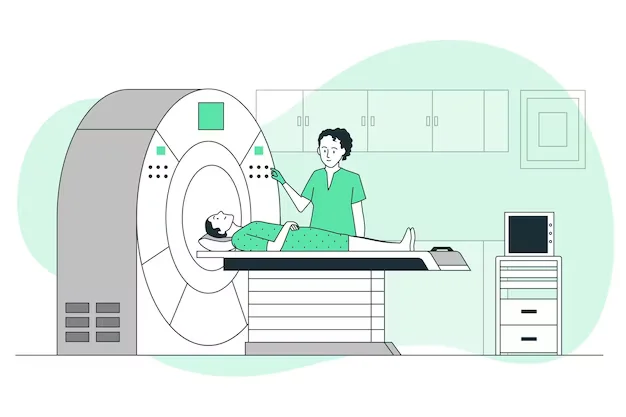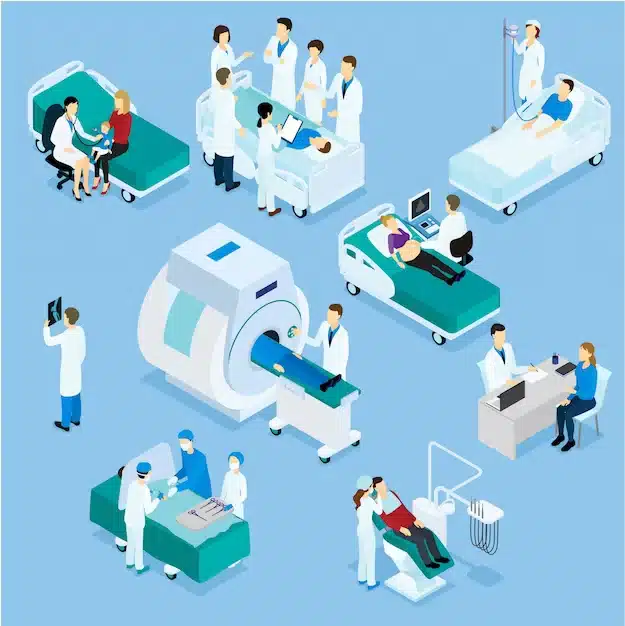Radiation therapy is a widely used treatment for cancer that has brought hope and healing to countless patients battling this disease. Radiation therapy also called as radiotherapy is a cancer treatment approach that employs high-energy radiation to target and destroy cancer cells, thereby inhibiting their growth and spread. According to research, approximately 50% of all cancer patients undergo radiation therapy at some point during their time of illness. Radiation therapy accounts for approximately 40% of the curative treatment options available for cancer.
While radiation therapy is undeniably one of the best treatment options for fighting cancer, one recurring question that often looms in the patient’s mind is- “Is radiation therapy painful? Just like any other treatment, radiation therapy also produces certain side effects (short-term, long term and late side effects). However, some of these side effects can be managed effectively with appropriate management ways.
This blog highlights information about radiation therapy, how it is performed, the recent advances and if it is painful or not. So please keep reading.
What are some recent advancements in Radiation Therapy Technology?
In recent years, there have been some remarkable advancements in the technology for radiation therapy. These radiation therapy advancements have paved a path to revolutionize the cancer treatment field and enhance patient outcomes. Some of the recent advancements in Radiation Therapy Technology include the following,
- Image-guided radiation therapy (IGRT)
- Intensity-modulated radiation therapy (IMRT)
- Stereotactic Body Radiation Therapy (SBRT)
- Proton Therapy
- Adaptive Radiation Therapy
Ayu Health Network of Hospitals is at the forefront of providing comprehensive radiation therapy services and expertise. Our team includes renowned experts from the field of oncology, such as Dr Niti Raizada,
How is radiation therapy performed?
Once diagnosed with cancer, the doctor will consider several factors, such as the cancer type, the stage of diagnosis, the patient’s age and overall health etc., to formulate the treatment plan. If radiation therapy is chosen, the treatment plan will be carefully planned to deliver the radiation doses to the cancer. There are two types of radiation therapy, external beam radiation therapy (EBRT) and internal beam radiation therapy. The following treatment plan is usually followed for giving radiation therapy.

Preparation for radiation therapy and what to expect before radiation therapy
The planning and preparation and planning of radiation therapy involves several steps; first, your radiation therapy team will assist you in choosing a comfortable position for treatment during a radiation simulation session. On the same type of table that will be utilized for your actual treatment, you will lie down for practice. In order to position you properly, they will also utilize cushions and other props, and occasionally a body mould or mesh face mask may be created to help keep you in place.
Your radiation therapy experts will then designate the precise area of your body that needs radiation treatment. Depending on your situation, you can indicate this with markers or tiny permanent tattoos. Additionally, planning scans, including MRIs and CT scans, will be carried out to create a unique radiation plan. You’ll wear the customized mask or mould for these scans while lying in the treatment posture.
Your care team will decide on the right kind and dosage of radiation for your treatment after the planning stage, taking into account the type of cancer you have, your general health, and your treatment objectives. In order to correctly focus the radiation beams on the malignant area while minimizing damage to neighbouring healthy cells, precise planning is essential. By minimizing potential adverse effects, increases the treatment’s effectiveness.
What happens during radiation therapy?
External beam radiation therapy
During external beam radiation therapy (EBRT), you lie on a table in the same position as during the simulation process. The radiation machine, which never touches you, moves around you. The machine precisely administers radiation dosages to the tumour as it changes places. You won’t feel anything over the course of the treatment, and the radiation is undetectable to the unaided eye. In order to administer radiation from various angles, the machine rotates around you.
EBRT is used as a localized treatment, focusing on a specific part of the body. For instance, radiation treatment for breast cancer concentrates on the chest region rather than the entire body. This strategy enables medical professionals to focus radiation on the tumour while reducing exposure to nearby healthy tissues.
Internal Beam radiation therapy
Internal radiation therapy is typically conducted in a specialized outpatient treatment room or a hospital setting. The radiation oncologist may use a catheter, a small flexible tube, to insert the radiation implant. Anesthesia will be administered to ensure you are comfortable and pain-free during the procedure. In the case of systemic internal radiation therapy, radioactive fluid is delivered through an IV.

The duration of your hospital stay for treatment will depend on factors such as the strength of the radiation and the size of the implant. In some instances, smaller implants may allow you to be discharged after treatment, accompanied by specific instructions to follow.
What happens after radiation therapy?
Following radiation therapy, it is common to undergo imaging tests to assess the response of the cancer to treatment. The timing of the response can vary, with some cases showing immediate improvement, while in others, it may take a few weeks or even months to observe the treatment’s effectiveness. It is important to consult with your radiation therapy team to understand what you can anticipate regarding the response and timeline specific to your situation.
Is Radiation Therapy Painful?
The procedure of administering radiation therapy is painless. You will not feel any pain, inflammation or discomfort when receiving radiation therapy. As the process of radiation is non-invasive in most cases, and the machine does not touch the body.
However, it is important to remeber that, although radiation therapy is a painless procedure, radiation therapy side effects are likely to occur after the radiation is given. The radiation therapy side effects will differ from person to person. You can know more about the side effects of radiation therapy here.
The radiation therapy team usually consists of the following people,
Who are on the Radiation Therapy Team?
- Radiation oncologist
- Radiation therapists
- Radiation oncology medical physicists
- Radiation oncology nurses
Conclusion
Radiation therapy remains one of the most commonly used treatments for cancer. Especially, with the recent advances in radiation therapy technology, better patient outcomes are seen. While the process of radiation therapy is not painful, it can produce certain side effects like any other treatment. Depending on the individual cases, either external beam or internal beam radiation therapy may be given to the patient for cancer treatment.
With highly skilled oncologists specializing in radiation therapy and an experienced and qualified staff team, the radiation therapy department at Ayu Health Network of Hospitals provides the best services to cancer patients. Our hospitals are equipped with all the latest technologies to deliver radiation therapy to our patients at affordable costs while ensuring good patient outcomes. Some of our doctors who are experts in the area are Dr Sanjay. R, Dr Geeta S. Narayanan, Dr Meenakshi Mittal. To know more, visit our website at www.ayu.health.
Frequently Asked Questions
1. At what stage of cancer is radiotherapy used?
Radiotherapy can be used at different stages of cancer, depending on the specific type and characteristics of the cancer. Radiation therapy can be given as,
- Primary treatment, either alone or in combination with other treatments such as surgery
- Adjuvant treatment, where it is used after surgery to destroy any remaining cancer cells
- Palliative treatment in the advanced stages of cancer
2. How long is recovery after radiation therapy?
The majority of side effects from radiation therapy typically subside within a few weeks to two months after completing the treatment. This is because it takes time for healthy cells to recover from the impact of radiation therapy. However, it is important to remember that some side effects may persist even after the treatment has ended. These late side effects can manifest months or even years after the completion of radiation therapy. The occurrence of late side effects is due to the prolonged impact of radiation on the body’s tissues and organs.
3. How many sessions of radiotherapy are normal?
Typically, individuals undergoing radiation therapy receive treatments five times a week, with one treatment administered each day from Monday to Friday. Weekends are usually designated as a break period without treatment. However, there are instances where treatment may be scheduled more frequently, including multiple treatments in a day or even over the weekend. The overall duration of the treatment course typically ranges from 1 to 7 weeks, depending on the specific cancer type and treatment plan.
4. Which type of cancer is most easily treated with radiotherapy?
The effectiveness of radiotherapy in treating cancer depends on various factors, which inlcudes the type and stage of cancer, its location, and individual patient characteristics. Some of the cancers that can be treated with radiotherapy may include the following,
- Breast cancer
- Bone cancer
- Brain tumor
- Colon cancer
- Head and neck cancers
- Lung cancer
- Liver cancer
- Prostate cancer
- Pancreatic cancer
- Spinal cord tumors
5. Is Stage 4 cancer curable with radiation?
Stage 4 cancer, also known as metastatic cancer, refers to cancer that has spread from its original site to distant parts of the body. Curing stage 4 cancer with only radiation therapy depends on several factors, which includes the type of cancer, the extent and locations of the metastases, and the patient’s overall health. In some instances, radiation therapy can be a crucial part of a comprehensive treatment approach for stage 4 cancer. t can be used to treat symptoms, control pain, reduce the size of tumors, and enhance the quality of life. Radiation therapy can be very effective in managing the condition and extending survival, even though it may not be a curative treatment for stage 4 cancer on its own.
Our Hospital Locations
Oncology Surgery Hospitals in Bangalore | Oncology Surgery Hospitals in Jaipur | Oncology Surgery Hospitals in NCR | Oncology Surgery Hospitals in Hyderabad
Our Doctors
Oncology Surgery Doctors in Bangalore | Oncology Surgery Doctors in Jaipur | Oncology Surgery Doctors in NCR | Oncology Surgery Doctors in Hyderabad
About the Author

Dr. S. Goel
Dr. S. Goel is a renowned Internal Medicine Specialist currently practicing at Ayu Health, Bangalore. He is a Specialist in Internal Medicine, Diabetes HTN, Paediatric Care, and Family Medicine.




